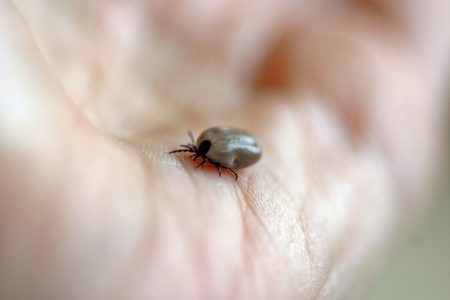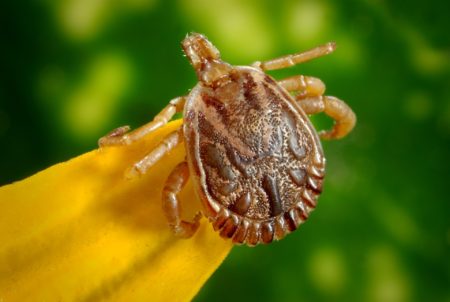Lyme Disease and Herbs That Can Help
In the US, around 300,000 people come down with Lyme disease each year (8) and those are the ones who get diagnosed instead of being misdiagnosed. Infections have been reported from all over the U.S., but most are still concentrated in the Upper Midwest, Mid Atlantic and Northeast regions. (8)
Lyme disease is caused by bacteria called spirochetes. These are long, slender, tightly coiled bacteria. (1). This bacterium can propel itself through its environment (you, the host), even though their tails are located inside their bodies. They are unusually shaped yet very active inside the host. (2).
Spirochetes are some of the worlds most ancient bacteria and have been around billions of years longer than we have and unfortunately for us, they are very, very smart. (3)
These bacteri can penetrate the body better than almost any other organism, in fact they can infect you within 10 minutes of being bitten! (3) The International Journal of General Medicine reports that average transmission time is 24 hours. (9) They cross barriers that are impenetrable to almost anything else and can pass through the endothelium which are membranes and linings of your organs. (2)
Some people will get the tell- tale sign of a tick bite-the bulls eye rash. This rash is caused by the result of the bacteria’s ability to burrow into the skin and soft tissue and bring on an inflammatory response. (2) However, many never get this clear sign of being bitten. In 2010, a study done in Maine found that only 43% of their Lyme patients exhibited the “Lyme Rash”. (7)
Lyme disease has devastated lives. It can cause damage to your organs, joints, brain and central nervous system. Because these spirochetes are so good at what they do and because they move so fast, they can find their way into your blood stream, lymph nodes, bone marrow, and spleen. (2)
Not only can it trigger autoimmune conditions and other health disorders, but it can mimic other diseases such as Parkinson’s disease, dementia and Alzheimer’s disease. (3d
What is Lyme Disease
Lyme disease is most often caused by Borrelia burgdorferi (Bb) and it was once thought that this was the only spirochete form that causes Lyme disease. New research indicates that another Borrelia bacteria, B. mayonii is closely related. (5). Europe and Asia have two additional Borrelia species that can cause Lyme. (6) The Bb form is thought to be the primary cause of Lyme arthritis and is the most common form found in the United States.
However, keep in mind that these species are not limited to the continents they were originally found on. For instance, birds can travel and carry the spirochete to new places. (3)
Information on Lyme Disease is constantly evolving as new research becomes available. For instance, by 2015, there were over 18 spirochete species discovered. Many of these new strains don’t have names and are identified by numbers instead. Each of these Borrelia species causes a different spectrum of symptoms (3). To make it even more complicated, each different species can have subspecies and each subspecies can have numerous strains.
Did I lose you?
The point is not to confuse you, but for you to see that if you get infected you aren’t infected with just one species but instead with similar but not identical genetic variants. (3)
And if that isn’t bad enough, you can also be infected with more than one type of Borrelia spirochete and each can cause a host of different symptoms. (3)
Even though the research is growing in Lyme disease, we still know very little about these infectious spirochetes. There are more types of these than we have originally thought and more to be found. For that reason, research in Lyme is going to still be evolving for quite some time. (3)
Lyme disease is most often associated with ticks but in truth you can also be infected from their feces, from mosquitos, fleas and biting insects. It comes from any blood sucking biting insect really. (3)
They need a host to survive and depend on you for nutrients. The B. burgdorferi gets most of its nutrients from your collagen and hence the reason for the joint pain in many Lyme sufferers.
However, as I did more research, I found that many associate this species with only joint pain but yet many infected with Bb also suffer from neurological symptoms as well. Those who are infected with Lyme show a wide variety of symptoms.
In the early stages, feeling like you have the flu is common. As the disease progresses symptoms often appear in one or all these three categories-skin, joint and neurological symptoms. Sadly, Lyme disease can mimic any disease!
Why So Many Cases of Lyme Disease in Recent Years?
Lyme disease has been around and has been infecting people for as long as humans have existed. (3). The reason it seems more prominent now is because, according to Stephen Harrod Buhner in Healing Lyme, is due to the fact they discovered one possible cause of arthritis. Once they discovered that the arthritis in some was caused by Lyme Disease, they also found out that it was at the root of other diseases as well. But, these weren’t other diseases, but symptoms caused by the same infection. (3) Because of what they do in the body, they can cause a wide range of symptoms and thus mimic a wide range of ailments and diseases!
This makes me wonder about all the people with RA, Lupus, fibromyalgia, dementia and so forth. While I am sure not all those suffering with these diseases have Lyme, but you have to wonder, how many do have Lyme and not being treated for it!
Stephen H. Buhner also attributes the increase in Lyme disease due to an increase in human population and the warming of the earth.
I also attribute it to our diet and lifestyle which I will explain more under the section of immune function.
Lyme Myths
- The tick needs to be attached to you for 36 to 48 hours for you to be infected. No, in fact it only needs 10 minutes to burrow and infect you and up to 72 hours. Studies have shown that transmission in 16 to 24 hours is the common time frame. (3, 9)
- What you are bitten by doesn’t matter, only that it carries the infectious bacteria. No. Certain types of hard ticks transmit the infection about twice as fast on average.
- Your health doesn’t matter if you get infected. Wrong, it does! Your immune function plays a major role. The stronger the immune system the slower the transmission time. The most important thing you can do, is support your immune system! (3)
- Testing is an accurate and reliable way to know if you have Lyme disease. No, see section on diagnosing below.
- Antibiotics are effective. No. If they were, why would so many still have Lyme Disease?
- You cannot infect your partner with Lyme disease. Interesting. New research is showing that yes, you can sexually transmit Lyme disease. (4)
- Borrelia burgdorferi is the only Lyme causing bacteria. No, this is what was once thought but new research shows this to be false. (5,3)
- You can only contract Lyme from ticks not other insects. No, you can get it from mosquitos, fleas, biting insects, and their feces (3)
- Animals cannot get infected with Lyme disease. In truth, these spirochetes will infect anything they can get away with biting, so it can be your dog or cat, other mammals, lizards and birds for instance. (3)
- If you still have symptoms, you still have Lyme disease. No, this is called Post Lyme Disease Syndrome (PLDS). These people are still suffering because of the tissue damage, the nervous system damage that was caused and that damage remains (3)
- You cannot get Lyme disease via a blood transfusion. Yes, you can! Some places are checking blood donations for Lyme but not all places are, so yes, it is possible to get it via a blood transfusion. While the risk may still be very low, someone may be infected with Lyme and unaware of it and donate blood. At this time there is no screening approved by the FDA. (19). For instance, a boy with cancer contracted Lyme from a blood donation. The donor had no symptoms and it was difficult to pinpoint his symptoms to Lyme since he was already ill. (20)
Symptoms
The symptom list is long and wide ranging. I suggest you read the extensive list in Healing Lyme, 2nd edition by Stephen Harrod Buhner.
Here are a few in the main 4 categories but this is a very short list. The long list would take up pages in this post.
- Painful skin
- Alopecia
- RA
- Cartilage damage
- Ruptured synovial cysts
- Muscle weakness
- Cognitive loss
- Alzheimer’s/dementia
- Hoarseness, soft voice
- Vertigo
- Bilateral hearing loss over time
- Depression/suicidal ideation
- Rage, violent mood swings
- MS
- Tremors
- Auditory hallucinations
- Lupus-like disorders
- Non-Hodgkin’s lymphoma
- Strokes
- CFS
- ADHD
As you can see a host of illnesses and diseases can be attributed to Lyme and what I shared is a very, very short list!
Why Lyme is So Difficult to Diagnose
Lyme disease can be challenging to diagnose for several reasons.
- It can mimic a host of other diseases
- Testing is not 100% reliable or accurate
- The bacteria can lie dormant in the body for years before causing symptoms
- In the first 2-4 weeks after being infected only ½ of the population will produce measurable antibodies to Lyme.
- IgM antibodies increase in the third week, peak from 4-6 weeks and will disappear by week 8
- IgG antibodies appear between 6 weeks and 3 months and can persist for years even after a successful treatment
- Antibody levels tend to peak at 60 days after infection and then drop to low levels that may not be detected with current testing.
- Antibiotic use can skew results and result in a false negative test result.
- The only reliable diagnostic marker is the bulls-eye rash. Yet, many do not get this rash, or they may get a rash that is a bit odd and not exactly a bulls-eye and the person may get diagnosed with some other skin disorder.
(3)
The Importance of a Healthy Immune System
The healthier you are before you got infected, the sooner you will get better. Often people with strong immune systems will not even know they contracted Lyme because their body can clear the infection right away. If your immune system is strong the tick cannot attach and feed. (3,12) Studies have shown that those with weaker immune function are not able to fight the infection effectively. (13)
Many believe that you do not get infected until 24 to 48 hours after the tick has been on you. Sadly, this not true, and you can become infected with the Lyme bacteria within 10 minutes. Once they enter the body they can alter their structure, evade the immune system and colonize in different parts of the body. This is a very smart bacterium! (3)
Lyme disease can shift your immune response from your T helper cells. T helper cells rapidly reproduce to begin making cytokines to help deal with the Lyme infection. Th1 cells usually stimulate highly inflammatory very active cytokines. Your Th 1 cells are specific for intracellular infections such as from microbes that hide inside other cells. The Lyme bacteria has learned to shift the response from a Th1 response to a Th2 response. This shift facilitates the Lyme infection and inhibits the immune response. (3) In early stages of the disease, you want to create a shift back to a Th1 dynamic so that your body can help to clear the infection. (3) For this, astragalus is the herb of choice. Astragalus is known as an immune stimulant and is used to enhance and bring balance back to the body. (14) In fact, if you live in Lyme prone areas, you may want to take this herb daily as a preventative measure.
Ashwagandha, is an herb that is known to help the body adapt to stress. It is also known for its immune function properties and in India it is often taken alongside antibiotics to prevent weakening of the immune system. (14)
It is critical to support the immune system long term and on-going! For long term immune support, I suggest, pre and probiotics, fermented foods, whole foods diet and immune supportive herbs and supplements such as vitamin C, zinc, astragalus, ashwagandha and Andrographis.
B. burgdorferi, Joint Pain and Inflammation
This form of Lyme can attach to and degrade your hyaluronic acid (HA), causing you pain. Hyaluronic acid is the lubricating fluid that is naturally found in your skin, eyes, joints, and connective tissue. Because it is found in the eyes, some people with Lyme Disease have visual disturbances. These spirochetes feed off your collagen. If it feeds off your collagen long term it can cause spontaneous tendon and ligament rupture and damage. (3)
Burgdorferi can penetrate the endothelial cell (EC) junctions, and this allows it to get deeper into the body’s tissue. When this happens, it stimulates the release of cytokines, which are proteins that are secreted by the immune system. This causes the EC junctions to loosen and creates a doorway deeper into the body. It then moves into the extra cellular matrix. This is a difficult area for the immune cells to penetrate and gives the Lyme a protected space to live in and survive and thrive. (3, 15)
This is one of the reasons why antibiotics may not be effective. Once B. burgdorferi gets deep into the cells it can resist antibiotic exposure for at least 14 days. Another reason can be due to the fact that the infectious spirochetes may have been destroyed by antibiotics, but the antigens can remain adjacent to the cartilage for an extended period of time after antibiotic treatment. (11)
Cytokines are your body’s natural response to infection however this can lead to an autoimmune response. The body’s immune system will begin to attack structures that are like the structure of the bacteria. (3)
Resveratrol, also known as Japanese knotweed, can stop the breakdown of the collagen and can put a halt to the disease process. It can inhibit the cytokine cascade that was initiated by the bacteria (16). Japanese knotweed is an excellent source of resveratrol. Resveratrol is also found in grapes except JK contains high concentrations of trans-resveratrol the active form of the compound and most useful for the human body. If buying resveratrol, look at the label to make sure it says trans-resveratrol. Otherwise and preferably, use Japanese knotweed.
In addition to this, adding in joint support in the form of HA is helpful and the bacteria will not feed off the supplement of HA (As far as I know from my research).
Biofilms, Encysted and A typical Lyme Forms and Antibiotics
Lyme can alter its form to withstand antibiotics and the immune response. Antibiotics will not be 100% effective because the B. burgdorferi will create encysted (cysts) forms during the infection. This means that it can take on a new form when confronted with adverse conditions. They create encysted forms to ensure they will survive in the host. (3)
Antibiotics can reduce the spirochetes by 90% and this sounds like a great thing. The problem is that it will also cause the B. burgdorferi to double the amount of atypical forms. The A typical forms are new forms that develop from the spirochetes. The longer that you have Lyme disease, the more A typical forms you will have. Again, this is part of their survival strategy. (3)
The longer the Lyme is in the host, the more atypical forms that emerge. A healthy immune system can kill the encysted forms, a weak immune system cannot! (3)
Many different types of bacteria and fungus have biofilms. These protective coverings provide a barrier for the bacteria that antibiotics cannot destroy
There are herbs and supplements that can destroy biofilms however you don’t want to rapidly destroy them because it can make your symptoms worse. Use herbs that will slowly break down the biofilms such as Andrographis and resveratrol.
Andrographis, has been used for hundreds of years to address parasites, malaria, liver dysfunction and to support the immune system. Andrographis is an effective herb to address Lyme disease due to its ant-parasitic compounds, it’s anti-inflammatory properties, and because it crosses the blood brain barrier (BBB) which is helpful if the Lyme disease has spread to the brain. Andrographis, however on its own, while very helpful, may not put Lyme into remission and you should use a Lyme protocol and not rely on just one herb to address the disease. (18)
In addition to this, another reason that antibiotics are not 100% effective is because the bacteria replicate very slowly, roughly every 1 to 16 days whereas other bacteria replicate every 20 minutes. (3)
How to Repel Ticks and Avoid Getting Bit
Use essential oils such as rosemary, lemongrass, cedar wood, peppermint, geraniol, citronella and clove for their strong acaricidal properties that make them safe organic options of tick control (10). You can add a few drops to a carrier oil such as coconut oil and then rub a bit of this mixture behind your ears, behind your knees, on your wrists and at base of the neck.
Other herbs that have been shown to destroy long persisting forms of the Lyme include garlic, allspice, cumin seed, lemongrass, myrrh, thyme, lemon eucalyptus, hedychium, amyris, and Litsea. (18)
Bottom Line: Herbs can be very useful remedies in the war against Lyme Disease. In my opinion, if you are suffering with an illness, pain or disease (and have tried many remedies and treatments already) and may be wondering if Lyme disease could be a root cause, I encourage you to consider an herbal protocol for Lyme disease and switch your diet to one that is very immune supportive.
Sources
(1) http://www.ucmp.berkely.edu/bacteria/spirochetes.html
(3) Buhner, S. (2015) Healing Lyme 2nd Edition. NM: Raven Press.
(4) https://www.lymedisease.org/lyme-sexual-transmission-2/
(6) https://www.ncbi.nlm.nih.gov/pmc/articles/PMC5029759/
(7) https://www.bayarealyme.org/blog/lyme-disease-bullseye-rash/
(8) https://www.cdc.gov/features/lymedisease/index.html
(9) https://www.ncbi.nlm.nih.gov/pmc/articles/PMC4278789
(10) http://blog.bioticsresearch.com/happy-tick-free-summer
(11) https://www.ncbi.nlm.nih.gov/pubmed/22728937
(13) https://www.ncbi.nih.nlm.gov/pmc/articles/PMC3187251/
(14) Mars, B. (2007) The Desktop Guide to Herbal Medicine. CA: Basic Health Publications
(15) Ingels, D. (2018) The Lyme Solution a 5-Part Plan. NY: Penguin Random House
(17) https://vitalplan.com/ingredients/resveratrol
(18) https://thetruthaboutcancer.com/lyme-disease-prevention/
(20) https://www.livescience.com/36912-boy-gets-rare-tick-infection-from-blood-transfusion.html







I got what you mean ,saved to my bookmarks, very nice web site.
I got what you mean ,saved to my bookmarks, very nice web site.